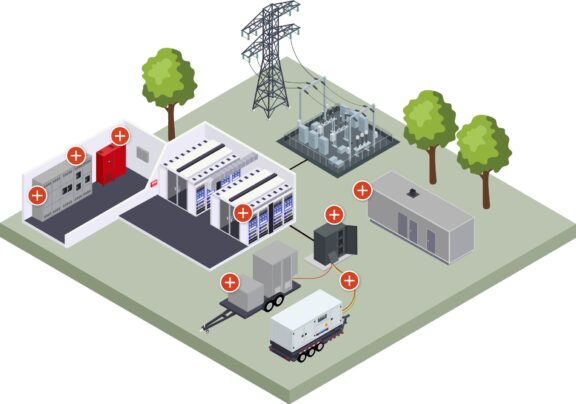
A backup generator ensures that your organization always has power, even if the electricity goes out. The generator needs to be ready to go in an emergency, which means you should regularly check that it’s in the best condition and is capable of performing. Load bank testing lets you assess the condition of your generators and minimizes the chance of wet stacking in diesel generators.
Load bank test reports also let you track the results from test after test. You can make updates or improvements to your equipment based on the load bank test data you collect.
What Is Load Bank Testing?
During load bank testing, a generator is put under various load conditions. The goal of the test is to measure how the generator reacts to varying loads. Load bank testing is one of the most accurate ways to test your equipment, as it provides consistently accurate results and lets you check multiple generators. You can easily adjust the power draw during a load bank test, which isn’t always possible with other testing options.
Load bank testing usually accomplishes two goals. It confirms that a backup generator is in good working condition and is ready to go if the main power supply goes out. It also ensures that a backup generator can reach its full power load when required. Performing regular load bank testing also minimizes the chance of wet stacking, which can occur when unburnt fuel mixes with soot, creating deposits in the exhaust system. Wet stacking reduces a generator’s efficiency.
Load Bank Tests Verify That Generators Are Working Properly
Many institutions, such as hospitals, data centers and government facilities, need to stay operational even when the primary power source has gone out. They also need to ensure that their backup power sources, such as generators, will be fully functional in a power outage. Load bank testing ensures that generators work correctly.
A load bank test evaluates several generator components to ensure proper operation.
- Voltage regulators: Voltage regulators ensure that the generator recovers quickly when large load changes occur. A resistive and inductive load bank test will verify that the voltage regulator is performing as it should be. When a regulator operates properly, the generator’s engine will quickly return to its steady-state condition after changing speed. A transient response test verifies that the voltage regulator is operational.
- Governors: A generator’s governors monitor, determine and limit engine speed under multiple conditions. There are three types of governors — electrical, mechanical and velocity. Each one plays a specific role in controlling engine speed, contributing to voltage loads. Load bank testing verifies that governors operate effectively.
- Cooling systems: A load bank test confirms that the cooling systems are operational in several ways. During the test, heat gets injected into the air stream, which can call attention to any weaknesses in the cooling system. The heat also stresses the radiator, thermostat and other system components, highlighting any potential issues. Collecting heat data during the test allows you to determine the temperature differential, which you can use to troubleshoot the system or verify compliance.
- Fuel systems: When a diesel generator doesn’t get used frequently at loads high enough to produce high exhaust temperatures, deposits build up on surfaces such as piping, mufflers, turbo turbine wheels and after-treatment systems. The buildup is at first a nuisance but can affect the generator’s performance over time. Load bank testing helps burn the fuel in the engine, reducing wet stacking and improving generator performance. Load bank testing can also help detect any issues in the fuel system, such as plugged filters or overheating.
- Controls: A generator’s controls can be very sensitive, putting them at risk of shutting down during load changes. Load testing verifies that the controls are fully operational or illuminates any issues in the system, such as circuit breaker trip settings, loose connections or voltage adjustments.

Generator Load Bank Tests Provide Valuable Data
Load bank test reports give you valuable data you can use to ensure consistency and analyze the performance of your generators.
Keeping accurate reports ensures that you run the same load bank test every time. You need to use the same parameters every time you test. Otherwise, you can’t accurately note trends or compare changes. Consistent test data gives you the information you need to make upgrades or schedule generator maintenance.
You can also use the data gathered during a load bank test to analyze the generator’s performance and understand the cause of any issues. For example, if you compare and collate data during and after a test, you can more easily detect the start of an issue or the factors that contributed to a problem. Knowing when a fault started and how it took place helps you determine what caused it and how you can avoid it going forward.
Generator Load Bank Testing Helps You Meet Codes
Your emergency power generator most likely needs to comply with several different codes. Accurate load test data and records are required for code compliance.
Some of the codes and regulations that you might need to comply with are:
- National Fire Protection Association (NFPA) 110: NFPA 110 sets standards to protect the building occupants. The code requires generator-powered backup lights to work as expected. A monthly test is needed where lighting failure could cause injury or death. A continuous load bank test might be required if a generator doesn’t pass the monthly test.
- National Electrical Code (NEC) 700 through 708: NEC codes 700 through 708 outline requirements for emergency systems, standby systems and critical operation power systems. The codes dictate which power systems are the most vital during emergencies.
- Joint Commission: Health care facilities, such as nursing homes and hospitals, need to test their emergency systems periodically to comply with Joint Commission requirements. Load bank testing should be performed monthly, and a full load test lasting at least four hours needs to be done every three years.
- Environmental Protection Agency (EPA) tier regulations: Load bank testing ensures that your diesel generator complies with the EPA’s tier regulations, which seek to control emissions from generators.
Find the Right Load Bank for Your Generator Testing Needs
Load Banks Direct manufacturers four basic load bank types and can create a custom load bank that suits your precise needs. Our individual load banks are rated from 50kW to 3000kW, meaning you’re sure to find one that meets the needs of your application. Browse our load bank solutions and contact us with any questions you have or for a quote.

We Are Here
To Help
Our team is here to support you and solve your power challenges. Connect with our responsive experts today to learn about our customized power solutions and products.


